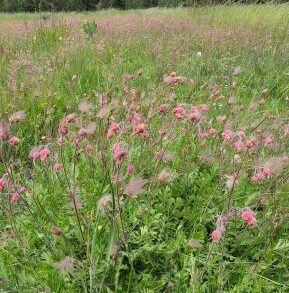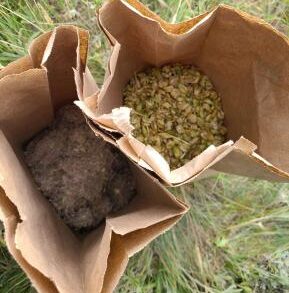Like every other work day, my seed collection partner, Tori, and I planned out a route through the forest to travel. Most of the first couple months working in the Helena-Lewis and Clark National Forest involved scouting out populations and exploring new parts of the forest, but this time would be the first day dedicated solely to seed collection and brought along two Montana Conservation Corps interns who were stationed at the same forest as us this summer. The population we would be collecting from was near a small pond in the Castle mountains of the Helena-Lewis and Clark National Forest. Tori had scouted it out at the end of last week and said it was ready to collect. The aim was to spend the whole day collecting Geum triflorum, or prairie smoke.

We drove for an hour and a half, stopping along the way to check on a population of Phacelia hastata, before arriving at the intended collection point. Strangely enough, we did not easily see the wispy fruits made by Geum triflorum and got out of the truck to inspect closer – in case they were blending in with the other plants in the area. On closer inspection, there were not nearly as many of the plants as we had seen when the population was first noted. Looking around the area, we realized that this location had been destroyed by grazing cattle based on the many cow patties around the area. We also noticed that the other side of a nearby fence was far more lush than the area around the pond – evidently the cows had not crossed to that side. Because of this, we decided to adapt our plan and move further down the road looking out for Geum triflorum outside of the intended collection point as well as checking on a Frasera speciosa (Green Gentian) population that we had recorded before.

Soon enough, we reached a scouting point we had made for Frasera speciosa and the population was perfect! The fruit pods were dried up and each fruit was full of mature seeds. Then we each armed ourselves with double-bagged paper bags and started collecting Frasera speciosa seeds. Each of us had our own preferred methods – either picking off the entire dried up fruits filled with seeds, sitting by a plant and dumping out the seeds, or bending over the top half of the plant into the bag and letting the seeds fall out with a few shakes. We continued for a couple hours before returning to the truck for lunch and then moved down the road a little more where we saw a moderate, ready to harvest, population of Geum triflorum too! To get both species at the same time, I tied two double-bagged paper bags to my belt, one for Frasera and the other for the Geum, and continued to collect both species for a few more hours – moving down the road just once more. A couple of us had earbuds in and were listening to music or podcasts while collecting and, since I had forgotten my own earbuds, I listened to the fire team talking over the forest service radio. At one point the clouds looked pretty ominous,but luckily they passed over us without any droplets and the rest of the time went well.


After returning to the station, we weighed each bag in order to calculate how many seeds we collected and set the seeds in a container with a no-bug strip for the weekend. After doing some math, we figured we collected about 50,000 viable Geum triflorum seeds and about 70,000 viable Frasera speciosa seeds on this one trip!

This was just the third day of actually collecting seeds for me, and I was happy with how it went! It was a little sad that the original location we planned to collect from had been destroyed, but sometimes things happen and we have to be able to adapt. So many things can prevent seed collection – from cows eating and trampling over the plants, missing the sometimes short fruiting times, a lack of fruiting (as we have seen so far with Frageria virginiana (virginia strawberry) and Berberis repens (creeping oregon-grape)), or the abundance of invasive species causing us to not be able to collect in an area. Even so, we were successful in still collecting the planned species as well as another in the same area and are hoping to switch over to mostly making collections for the rest of the season!

